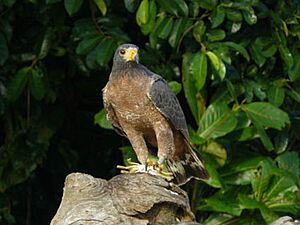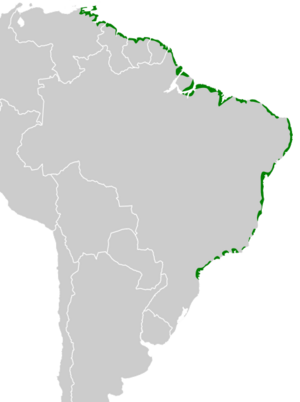Rufous crab hawk facts for kids
Quick facts for kids Rufous crab hawk |
|
|---|---|
 |
|
| Conservation status | |
| Scientific classification | |
| Genus: |
Buteogallus
|
| Species: |
aequinoctialis
|
 |
|
The rufous crab hawk (Buteogallus aequinoctialis) is a cool bird of prey that lives near the coast. It's also called the rufous crab-hawk. These birds are known for hunting crabs! You can find them on the island of Trinidad and along the coast of South America. This includes places from eastern Venezuela all the way to southern Brazil. Scientists consider this bird a Near Threatened species, which means its population needs to be watched carefully.
Contents
About the Rufous Crab Hawk's Name
Every animal has a special scientific name, and the rufous crab hawk's is Buteogallus aequinoctialis. A German scientist named Johann Friedrich Gmelin first officially described this bird in 1788. He gave it the name Falco aequinoctialis back then.
Later, in 1830, a French scientist named René Lesson put this bird into a new group called Buteogallus. This group name combines parts of other bird names. The second part of its scientific name, aequinoctialis, comes from a Latin word meaning "equinoctial." This bird is unique because it doesn't have any different types or subspecies.
What Does a Rufous Crab Hawk Look Like?
The rufous crab hawk is a medium-sized bird. It is about 42.5 to 46 centimeters (16.7 to 18.1 inches) long. Its wings can spread out from 90 to 106 centimeters (35 to 42 inches) wide.
Male rufous crab hawks weigh between 506 to 665 grams (17.8 to 23.5 ounces). Female birds are a bit heavier, weighing around 725 to 945 grams (25.6 to 33.3 ounces). Both male and female birds look very similar.
Adult birds have a dark, sooty black head, throat, and neck. Their back is a dark reddish-brown color with lighter reddish-brown edges. Their belly and chest are reddish-brown with thin, dark stripes. Their tail is black with a white tip and a thin white stripe across it. They have brown eyes, and their cere (the waxy part above their beak) and feet are yellow to a dark orange color. Young rufous crab hawks look a bit different. They have brown to blackish-brown upper parts, a grayish tail, and white underparts with dark streaks.
Where Do Rufous Crab Hawks Live?
You can find the rufous crab hawk on the island of Trinidad. On the mainland of South America, they live along the coast. Their home stretches from the Orinoco Delta in Venezuela, through countries like Guyana, Suriname, and French Guiana (together known as the Guianas), and down into Brazil. They can be found as far south as the state of Paraná in southeastern Brazil.
These birds mostly live in mangrove forests. These are special forests that grow in salty water along coastlines. They also live in swamps, wet grasslands called savannas, and along river edges near the coast. All these places are usually at sea level.
How Rufous Crab Hawks Behave
Movement
Rufous crab hawks usually stay in one area and do not migrate far. They are often seen in pairs.
Feeding Habits
The rufous crab hawk's diet is mostly, and maybe even entirely, made up of crabs. They catch crabs by diving down from a low branch or perch. After catching a crab, they often take it to a favorite spot, like a tree stump, to eat it.
Reproduction and Life Cycle
Rufous crab hawks perform a special "sky-dance" display, which is thought to be done only by the male. The time of year they breed changes depending on where they live. For example, in Suriname, they breed between February and August. In southeastern Brazil, it seems to be from September onwards.
They build their nests out of twigs and line them with leaves. They usually build their nests in a mangrove tree or another tree close to water. A female rufous crab hawk usually lays one egg, but sometimes she lays two. Scientists don't yet know how long the eggs take to hatch or how long it takes for the young birds to be ready to fly.
What Do They Sound Like?
The rufous crab hawk makes a loud, high-pitched whistle or a sound that some describe as a laugh. It sounds like "ke-kee-kee-kee-kew-kew."
Is the Rufous Crab Hawk in Danger?
The IUCN (International Union for Conservation of Nature) is an organization that checks on how safe animal populations are. They first thought the rufous crab hawk was of "Least Concern," meaning it was not in much danger. But since 2013, they have changed its status to "Near Threatened." This means that while it's not in immediate danger, its population is decreasing, and it needs to be watched closely.
We don't know exactly how many rufous crab hawks there are, but their numbers are believed to be going down. The biggest threat to these birds is the ongoing destruction of their mangrove homes. Even though they can sometimes live in disturbed mangrove areas, their special habitat makes them very sensitive to any damage or loss of these important coastal forests.


